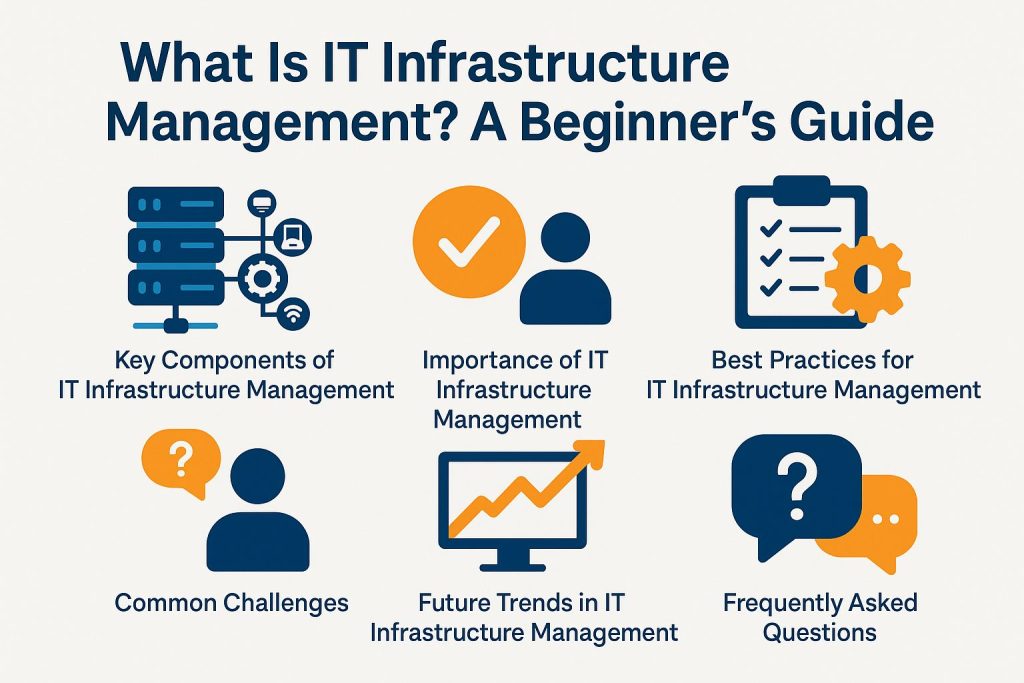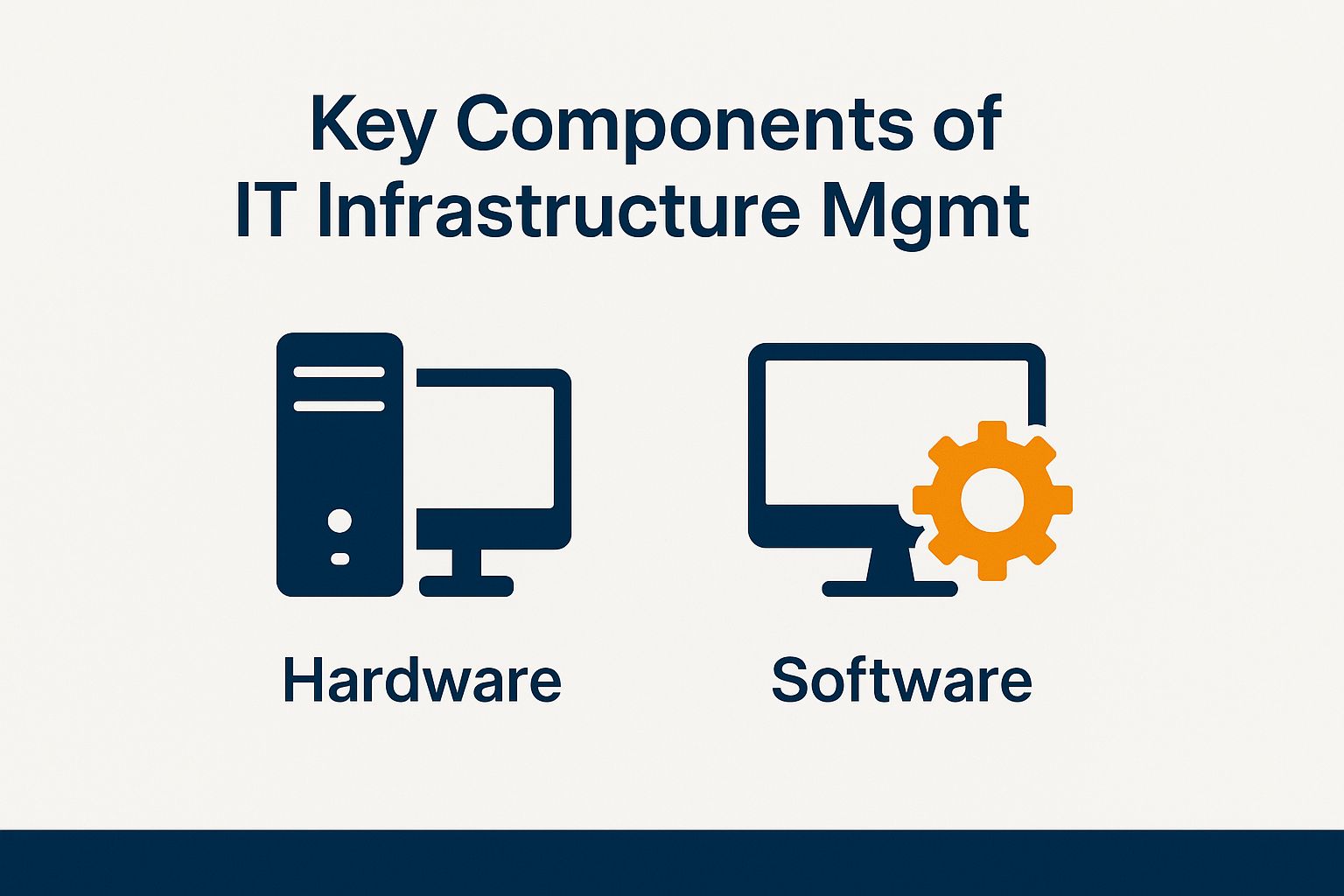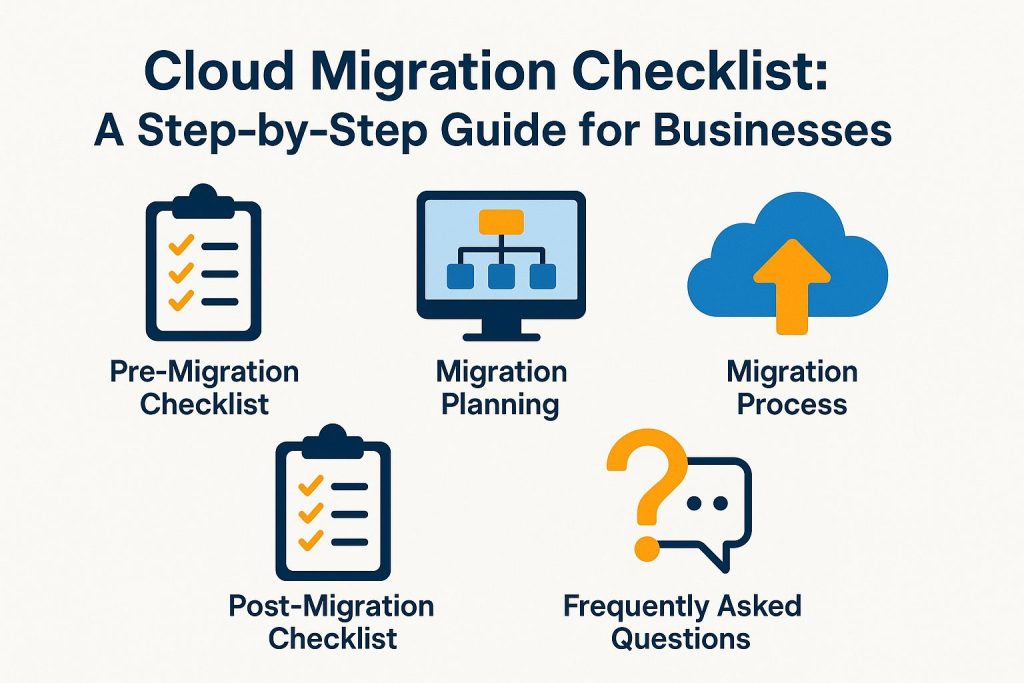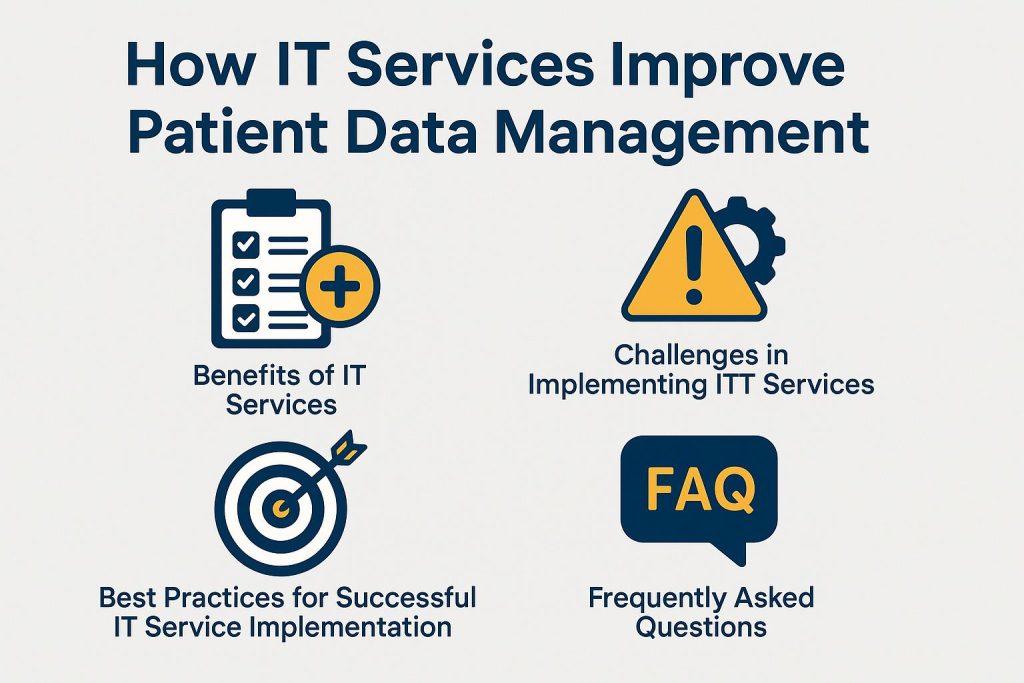What Is IT Infrastructure Management? A Beginner’s Guide

Effective IT infrastructure management is crucial for organizational success in today’s interconnected world. Understanding key components helps professionals navigate complex technology. These components include hardware, software, best practices, and trends. Robust IT management is significant for operational efficiency and strategic growth. This guide will help readers understand this essential area.
Key Components of IT Infrastructure Management
A comprehensive understanding of the key components of IT infrastructure is essential. It helps establish a strong framework that supports an organization’s IT strategy. Implement this by following the methodology in our IT Framework for Asheville Enterprises guide.

Hardware
IT hardware encompasses essential physical components, including servers, routers, and switches, that form the foundation of any IT infrastructure. Key types of IT hardware include servers, which are responsible for managing and storing data. An example is the Dell PowerEdge T40, recognized for its efficient processing power and reliability.
Networking equipment is vital for effective communication; for instance, Cisco routers are known for providing robust and secure connections. Additionally, storage devices such as the Western Digital NAS deliver scalable storage solutions, making them ideal for backup and data retrieval.
These components work together to create a resilient infrastructure. They ensure data availability and security throughout the organization.
Software
Software applications, encompassing operating systems and virtualization platforms, are essential for the effective management of hardware resources. One notable operating system is Windows Server 2022, which features enhanced security and scalability, making it particularly suitable for enterprise environments.
For the management of virtual machines, VMware vSphere delivers robust virtualization capabilities that enable users to optimize resource utilization efficiently. In terms of monitoring, Nagios stands out as an excellent tool for ensuring system uptime and performance, providing real-time alerts to administrators regarding any emerging issues.
Pricing for these IT infrastructure components varies:
- Windows Server typically starts at around $900,
- VMware vSphere licenses are approximately $995,
- Nagios offers a free core version along with paid options for advanced features.
Importance of IT Infrastructure Management
Efficient IT infrastructure management enhances operational efficiency. It helps organizations respond quickly to changing business needs with the help of robust IT governance.
Organizations should conduct regular audits with tools like SolarWinds for comprehensive network monitoring. Regularly scheduled audits can help identify bottlenecks, and tools like SolarWinds can facilitate this process through automated reporting.
Additionally, adopting cloud services like AWS or Azure can improve scalability, ensuring that resources are aligned with fluctuations in demand. Company X’s case study shows the benefits of disciplined IT management. The company reduced downtime by 25%, highlighting the advantages of responsive strategies.
Best Practices for IT Infrastructure Management
Implementing best practices in IT infrastructure management is crucial for maximizing performance and minimizing risks. To achieve this, organizations should conduct regular audits utilizing tools such as SolarWinds for comprehensive network monitoring. The adoption of cloud solutions, like AWS, enhances scalability and improves data accessibility. For those interested, our Cloud Migration Checklist: A Step-by-Step Guide for Businesses provides valuable insights into optimizing this transition effectively.
Automating routine tasks through configuration management tools such as Ansible allows organizations to free up valuable IT resources. Systematic documentation of processes ensures consistency across teams, while investing in training programs for IT staff helps maintain up-to-date skills.
For instance, Company X experienced a 30% reduction in downtime after implementing these strategies.
Common Challenges
Organizations face challenges managing their IT infrastructure. These challenges can negatively impact success if not addressed.
Managing hybrid clouds and infrastructure as code is complex. Tools like VMware Cloud Foundation and Microsoft Azure Arc can help integrate different environments.
Organizations should implement strong security protocols to reduce data breach risks. These include multi-factor authentication and encryption.
High-profile breaches, like Equifax, show the need for these measures.
To comply with regulations like GDPR, organizations can use software like OneTrust. This software simplifies data mapping and consent management.
To fix integration issues with legacy systems, companies use middleware solutions like MuleSoft. This helps improve workflows and IT operations.
Future Trends in IT Infrastructure Management
IT infrastructure management is changing quickly. This is due to new technology and changing business needs.
One trend is the growing use of artificial intelligence for system monitoring. Tools like Splunk are leading in this area.
These solutions provide real-time insights and predictive analytics. This helps businesses resolve issues before they escalate.
Another important trend is serverless architectures. They let organizations scale operations without managing hardware.
Platforms like AWS Lambda are expected to grow by 20% each year, showing this trend.
Edge computing is also growing, especially in Internet of Things (IoT) applications. It reduces latency by processing data closer to where it is generated. Together, these trends signify a substantial shift toward more agile and efficient IT infrastructures.
Frequently Asked Questions
What is IT infrastructure management? Why is it important?
IT infrastructure management includes the processes, policies, and tools to plan, design, and maintain IT infrastructure.
It is important because good management leads to efficient operations, supports business growth, and improves security and compliance.
What are the main components of IT infrastructure?
The main components of IT infrastructure are hardware, software, networking, data storage, and IT services.
Hardware includes physical devices like servers, computers, and mobile devices.
Software includes operating systems, applications, and security programs.
Networking is the connections and communication between devices.
Data storage is about storing and retrieving data.
IT services include support, maintenance, and infrastructure management.
What are the key responsibilities of an IT infrastructure manager?
An IT infrastructure manager is responsible for developing and implementing policies, ensuring system availability and performance, managing security and compliance, coordinating upgrades and maintenance, and overseeing the budget.
What are the advantages of effective IT infrastructure management?
Effective IT infrastructure management can increase efficiency and productivity, reduce downtime and costs, improve security and compliance, enhance scalability and flexibility, and boost customer satisfaction.
What are the top practices for IT infrastructure management?
Best practices for IT infrastructure management include regular monitoring and maintenance, disaster recovery plans, automation, standardization, security audits, and staying updated with industry trends.
How can beginners start with IT infrastructure management?
Beginners can start by learning the basics of hardware, software, and networking. They should also familiarize themselves with common IT policies and consider courses or certifications.
Gaining experience through internships or entry-level IT positions is also helpful.




